Page 116 of 468

2-33
If your engine speed drops below 600 rpm, or if the
engine is not running smoothly, you should downshift to
the next lower gear. When operating on slippery
surfaces, downshift at lower than normal vehicle speeds
to prevent the tires from slipping.
In bench seat equipped vehicles, move the tallest
beverage containers to the right cupholder to provide
additional clearance for the shift lever.
For vehicles equipped with a center console, the front
cup holder pulls out and turns 180� to provide additional
clearance between tall beverage containers and the
shift lever.Shift Light
If you have a manual
transmission, you may have
a SHIFT light. This light
will show you when to shift
to the next higher gear for
best fuel economy.
When this light comes on, you can shift to the next
higher gear if weather, road and traffic conditions allow.
For the best fuel economy, accelerate slowly and shift
when the light comes on.
While you accelerate, it is normal for the light to go on and
off if you quickly change the position of the accelerator.
If your vehicle has four
-wheel drive and is equipped
with a manual transmission, disregard the SHIFT light
when the transfer case is in 4
-Wheel Low.
Ignore the SHIFT light when you downshift.
Page 118 of 468
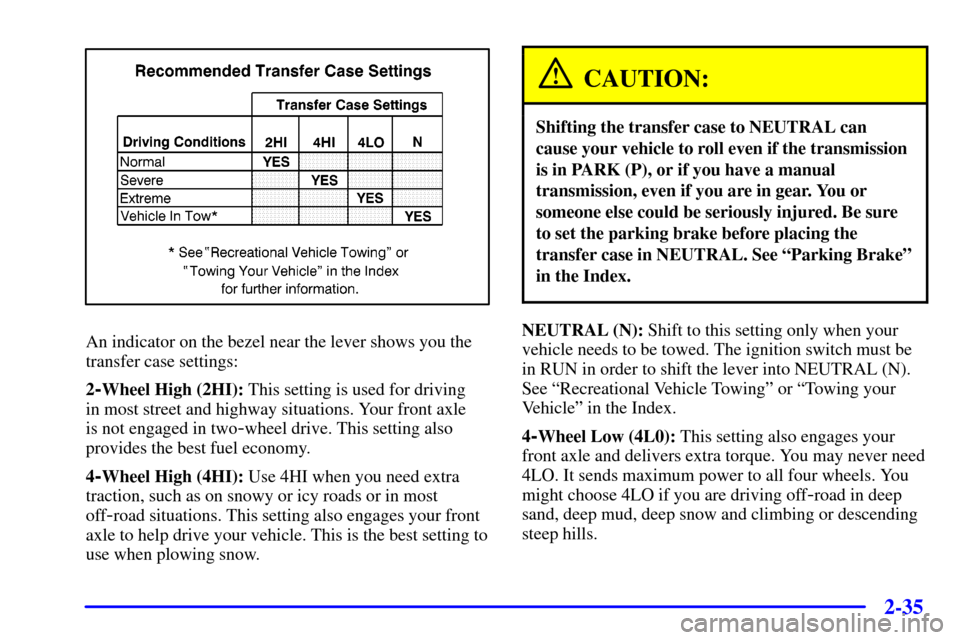
2-35
An indicator on the bezel near the lever shows you the
transfer case settings:
2
-Wheel High (2HI): This setting is used for driving
in most street and highway situations. Your front axle
is not engaged in two
-wheel drive. This setting also
provides the best fuel economy.
4
-Wheel High (4HI): Use 4HI when you need extra
traction, such as on snowy or icy roads or in most
off
-road situations. This setting also engages your front
axle to help drive your vehicle. This is the best setting to
use when plowing snow.
CAUTION:
Shifting the transfer case to NEUTRAL can
cause your vehicle to roll even if the transmission
is in PARK (P), or if you have a manual
transmission, even if you are in gear. You or
someone else could be seriously injured. Be sure
to set the parking brake before placing the
transfer case in NEUTRAL. See ªParking Brakeº
in the Index.
NEUTRAL (N): Shift to this setting only when your
vehicle needs to be towed. The ignition switch must be
in RUN in order to shift the lever into NEUTRAL (N).
See ªRecreational Vehicle Towingº or ªTowing your
Vehicleº in the Index.
4
-Wheel Low (4L0): This setting also engages your
front axle and delivers extra torque. You may never need
4LO. It sends maximum power to all four wheels. You
might choose 4LO if you are driving off
-road in deep
sand, deep mud, deep snow and climbing or descending
steep hills.
Page 119 of 468
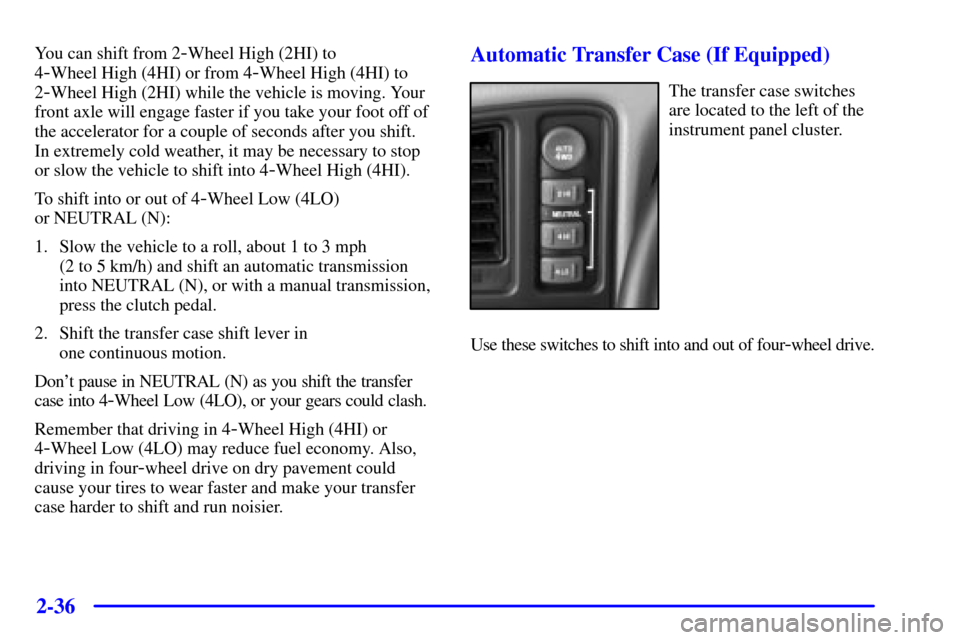
2-36
You can shift from 2-Wheel High (2HI) to
4
-Wheel High (4HI) or from 4-Wheel High (4HI) to
2
-Wheel High (2HI) while the vehicle is moving. Your
front axle will engage faster if you take your foot off of
the accelerator for a couple of seconds after you shift.
In extremely cold weather, it may be necessary to stop
or slow the vehicle to shift into 4
-Wheel High (4HI).
To shift into or out of 4
-Wheel Low (4LO)
or NEUTRAL (N):
1. Slow the vehicle to a roll, about 1 to 3 mph
(2 to 5 km/h) and shift an automatic transmission
into NEUTRAL (N), or with a manual transmission,
press the clutch pedal.
2. Shift the transfer case shift lever in
one continuous motion.
Don't pause in NEUTRAL (N) as you shift the transfer
case into 4
-Wheel Low (4LO), or your gears could clash.
Remember that driving in 4
-Wheel High (4HI) or
4
-Wheel Low (4LO) may reduce fuel economy. Also,
driving in four
-wheel drive on dry pavement could
cause your tires to wear faster and make your transfer
case harder to shift and run noisier.
Automatic Transfer Case (If Equipped)
The transfer case switches
are located to the left of the
instrument panel cluster.
Use these switches to shift into and out of four
-wheel drive.
Page 128 of 468
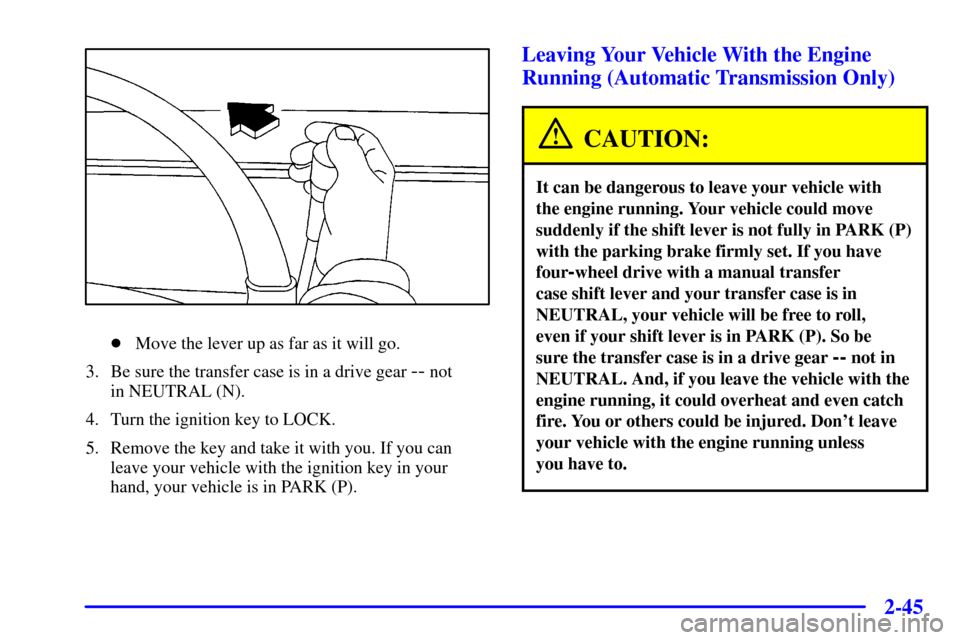
2-45
�Move the lever up as far as it will go.
3. Be sure the transfer case is in a drive gear
-- not
in NEUTRAL (N).
4. Turn the ignition key to LOCK.
5. Remove the key and take it with you. If you can
leave your vehicle with the ignition key in your
hand, your vehicle is in PARK (P).
Leaving Your Vehicle With the Engine
Running (Automatic Transmission Only)
CAUTION:
It can be dangerous to leave your vehicle with
the engine running. Your vehicle could move
suddenly if the shift lever is not fully in PARK (P)
with the parking brake firmly set. If you have
four
-wheel drive with a manual transfer
case shift lever and your transfer case is in
NEUTRAL, your vehicle will be free to roll,
even if your shift lever is in PARK (P). So be
sure the transfer case is in a drive gear
-- not in
NEUTRAL. And, if you leave the vehicle with the
engine running, it could overheat and even catch
fire. You or others could be injured. Don't leave
your vehicle with the engine running unless
you have to.
Page 130 of 468
2-47
Parking Your Vehicle
(Manual Transmission Models Only)
CAUTION:
Shifting the transfer case to NEUTRAL can
cause your vehicle to roll even if the manual
transmission is in gear. You or someone else could
be seriously injured. Be sure to set the parking
brake before placing the transfer case in
NEUTRAL. See ªParking Brakeº in the Index.
Before you get out of your vehicle, move the shift lever
into REVERSE (R), and firmly apply the parking brake.
Once the shift lever has been placed into REVERSE (R)
with the clutch pedal pressed in, you can turn the ignition
key to OFF, remove the key and release the clutch.
If you are parking on a hill, or if you are pulling a
trailer, see ªTowing a Trailerº in the Index.
Parking Over Things That Burn
CAUTION:
Things that can burn could touch hot exhaust
parts under your vehicle and ignite. Don't park
over papers, leaves, dry grass or other things that
can burn.
Page 142 of 468

2-59
To idle your vehicle with the automatic headlamp
system off, set the parking brake while the ignition is
off. Then start your vehicle. The automatic headlamp
system will stay off until you release the parking brake.
You may be able to turn off your automatic headlamp
system. See ªDaytime Running Lamps (DRL)º later in
this section for more information.
As with any vehicle, you should turn on the regular
headlamp system when you need it.
Lamps On Reminder
A reminder chime will sound when your headlamps or
parking lamps are manually turned on and your ignition
is in OFF, LOCK or ACCESSORY. To disable the
chime, turn the thumbwheel all the way down. In the
automatic mode, the headlamps turn off once the
ignition key is in OFF.
Daytime Running Lamps
Daytime Running Lamps (DRL) can make it easier for
others to see the front of your vehicle during the day.
DRL can be helpful in many different driving
conditions, but they can be especially helpful in the
short periods after dawn and before sunset.
Fully functional daytime running lights are required
on all vehicles first sold in Canada.The DRL system will come on when the following
conditions are met:
�the ignition is on,
�the headlamp switch is in automatic headlamp mode,
�the automatic transmission is not in PARK (P),
�the light sensor determines it is daytime and
�the parking brake is released.
When the DRL are on, only your DRL lamps will be on.
The taillamps, sidemarker and other lamps won't be on.
The instrument panel won't be lit up either.
When it begins to get dark, the automatic headlamp
system will switch from DRL to the headlamps or the
last chosen headlamp setting that was used.
When you turn the headlamp switch off, the headlamps
will go off, and your DRL lamps will illuminate,
provided it is not dark outside.
To idle an automatic transmission equipped vehicle with
the DRL off, set the parking brake. Shifting the
transmission into PARK (P) will also allow you to idle
the vehicle with the DRL off. The DRL will stay off
until you release the parking brake or shift the
transmission out of PARK (P).
Page 143 of 468
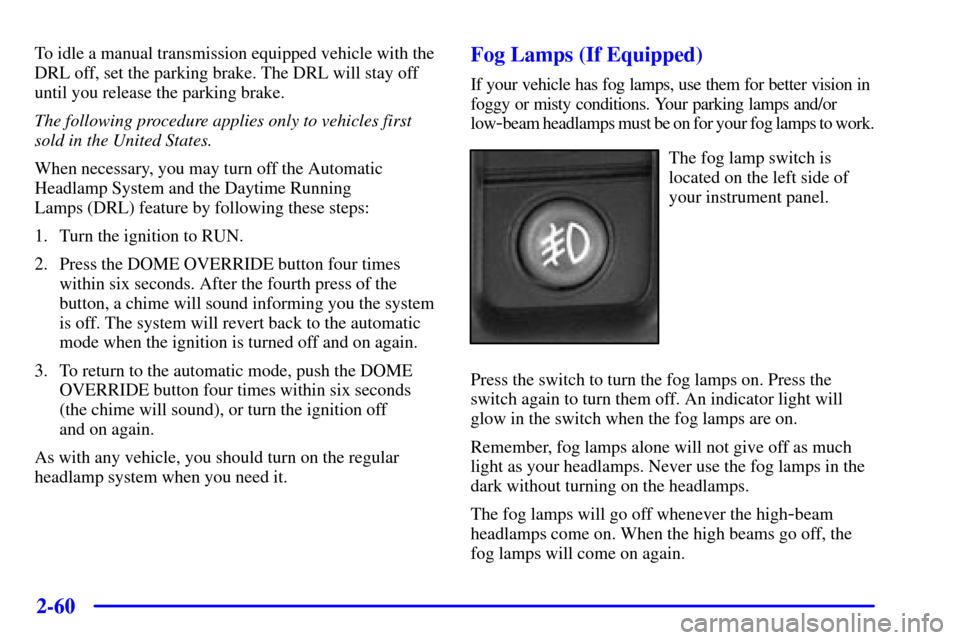
2-60
To idle a manual transmission equipped vehicle with the
DRL off, set the parking brake. The DRL will stay off
until you release the parking brake.
The following procedure applies only to vehicles first
sold in the United States.
When necessary, you may turn off the Automatic
Headlamp System and the Daytime Running
Lamps (DRL) feature by following these steps:
1. Turn the ignition to RUN.
2. Press the DOME OVERRIDE button four times
within six seconds. After the fourth press of the
button, a chime will sound informing you the system
is off. The system will revert back to the automatic
mode when the ignition is turned off and on again.
3. To return to the automatic mode, push the DOME
OVERRIDE button four times within six seconds
(the chime will sound), or turn the ignition off
and on again.
As with any vehicle, you should turn on the regular
headlamp system when you need it.Fog Lamps (If Equipped)
If your vehicle has fog lamps, use them for better vision in
foggy or misty conditions. Your parking lamps and/or
low
-beam headlamps must be on for your fog lamps to work.
The fog lamp switch is
located on the left side of
your instrument panel.
Press the switch to turn the fog lamps on. Press the
switch again to turn them off. An indicator light will
glow in the switch when the fog lamps are on.
Remember, fog lamps alone will not give off as much
light as your headlamps. Never use the fog lamps in the
dark without turning on the headlamps.
The fog lamps will go off whenever the high
-beam
headlamps come on. When the high beams go off, the
fog lamps will come on again.
Page 155 of 468
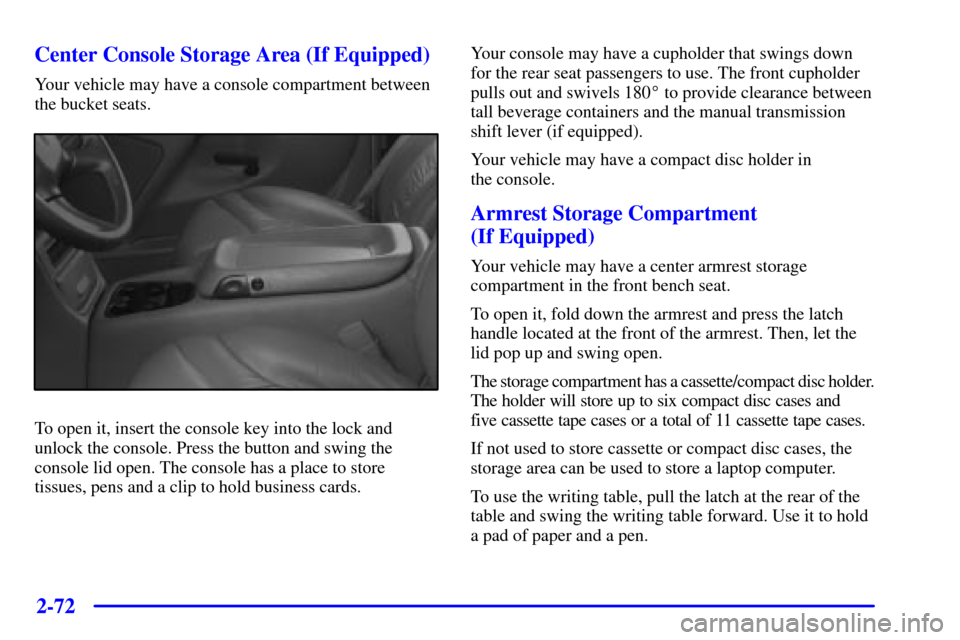
2-72
Center Console Storage Area (If Equipped)
Your vehicle may have a console compartment between
the bucket seats.
To open it, insert the console key into the lock and
unlock the console. Press the button and swing the
console lid open. The console has a place to store
tissues, pens and a clip to hold business cards.Your console may have a cupholder that swings down
for the rear seat passengers to use. The front cupholder
pulls out and swivels 180� to provide clearance between
tall beverage containers and the manual transmission
shift lever (if equipped).
Your vehicle may have a compact disc holder in
the console.
Armrest Storage Compartment
(If Equipped)
Your vehicle may have a center armrest storage
compartment in the front bench seat.
To open it, fold down the armrest and press the latch
handle located at the front of the armrest. Then, let the
lid pop up and swing open.
The storage compartment has a cassette/compact disc holder.
The holder will store up to six compact disc cases and
five cassette tape cases or a total of 11 cassette tape cases.
If not used to store cassette or compact disc cases, the
storage area can be used to store a laptop computer.
To use the writing table, pull the latch at the rear of the
table and swing the writing table forward. Use it to hold
a pad of paper and a pen.